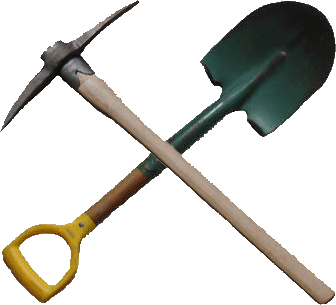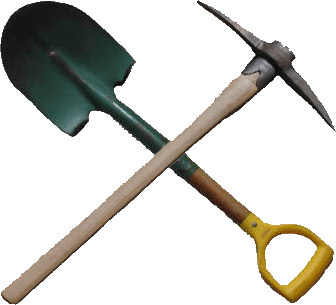|
|
Gold Facts:
A yellow "Noble" or base metal, noted for its rarity, resistance to corrosion, malleability and ductility. The chemical symbol is Au, from Aurora or dawn. Auroma was the Roman goddess of dawn. It can be hammered into flat sheets or "leaves" only 0.00001mm thick, and one ounce can be drawn into 50 miles of thin gold wire. It can be dissolved by cyanide and by aqua regia, a mixture of nitric and hydrochloric acids, which is applicable to the mining and refining (purifying) of gold. Throughout history gold has been used as jewelry and as sculpture. Gold has been used in many religions for temples, icons, statuary and other purposes. For over 7,000 years gold has been a storehouse of wealth and used as a medium of exchange. In modern times gold is still used in all of the traditional ways and has become a staple in telecommunications, information technology, medical treatments, dentistry and various other industrial applications. Due to its high electrical conductivity, gold is a vital component of many electrical devices, including satellites, computers, televisions, DVDs, VCRs, video cameras and mobile phones.
Gold properties:
Symbol: Au
Atomic Number: 79
Atomic Weight: 196.967
Melting Point: 1945 degrees F/1063 degrees C
Specific gravity: 19.32 – the sixth heaviest metal
Hardness: (Moh’s Scale) 2.5 - 3.0
Tensile Strength: 11.9
Found in the Earth’s crust at 0.005 ppm.
Gold Mining:
Gold can be mined in two primary types of deposits. The first type is called Lode deposits or Vein deposits. Lode deposits are deposits where gold is found in cracks and veins in rocks. The second type of gold deposits are called Placer deposits which are small particles or nuggets of gold (free gold), found in easily accessible surface material. Placer deposits can be formed in two ways. The first type of Placer deposit is a Streambed Placer and is formed by swiftly moving water that has eroded (freed) gold out of lode deposits. When the velocity of the water in a river slows sufficiently, the heavy gold falls to the bottom and accumulates in the sand of the riverbed. The other type of Placer deposit is called a Desert Placer and they are formed by the slow erosional forces of wind and rain in desert (generally) regions. Gold is also available as a by-product of copper and silver mining. Learn about our mining methods by clicking HERE.
Gold Nuggets:
Chunks or pieces of gold, mainly found in Placer deposits are known as nuggets. The largest nugget is called the "Welcome Stranger", found in Australia in 1858, which weighed 2,284 ounces (71.04 kilos). It is not unusual for nuggets to have a gold content over 900 fine and may even be close to 995. Natural gold nuggets typically sell for a premium price over the spot gold price because they are valued similarly to gem stones and are much rarer than fine gold dust or even diamonds!. Gold Nuggets represent less than one percent of the World’s gold! Each gold nugget is unique, and they are in demand from museums, private collectors, knowledgable Gold Bugs, and the jewelry industry. Much of the gold bullion traded on the stock market is made from refined and melted down gold dust to form bars; 95-98% of the world's native gold is actually in the form of gold dust and not gold nuggets.
Unfortunately, almost all gold nuggets found prior to 1990 have been melted down. During the gold rushes, even the largest nuggets were melted down, formed into bars or coins and assayed to determine their gold value so that payment for goods and services could be easily obtained. The Great Depression and the raw gold price spikes during the 1980's saw many of the best surviving nuggets held by state governments, museums and private collectors being melted down for cash. Only very recently has the appreciation of geological rarity, uniqueness and nostalgia replaced the greed and fear that determined the fate of placer and lode nuggets in the past.
Common measurements of gold:
Grain - (gr)
One of the earliest units of weight for gold was the grain measurement. It was determined by the weight of one grain seed, taken from the middle of the ear of barley.
Gram - (g)
a gram is one one-thousandth of a kilogram.
Pennyweight - (dwt)
Originally, the weight of a silver penny in Britain in the Middle Ages. A pennyweight is a unit of mass which is the same as 24 grains, 1/240th of a troy pound, 1/20th of a troy ounce, approximately 0.055 ounces or approximately 1.555 grams. While "dwt" is the most common abbreviation for pennyweight (as "d" was the abbreviation for "penny" in the pre-decimalisation British system), some sources list "pwt" or "PW" as an alternative. Some "old-timers" refer to this measurement as a "dimeweight" probably due to it's abbreviation. This measure is still widely used in North America as the unit of weight in the jewelry trade.
Troy Ounce - (ozt)
The traditional unit of weight for gold is the troy ounce, being 31.1034807 grams. It is thought, its name was derived from the annual fair at Troyes in France in the Middle Ages. The troy ounce remains the basic international unit in which the price of good delivery bars of gold and silver are quoted, even though the metric system is growing in use in mining and the gold industry.
1 grain = 0.0648 grams or 0.002083 troy ounces
1 Gram = 15.43 grains or .643 pennyweight
1 pennyweight = 24 grains
1 troy ounce = 480.6 grains
1 troy ounce = 31.1 grams
1 troy ounce = 20 pennyweights
1 troy ounce = 1.097 ordinary (avoirdupois) ounces
1 kilogram = 32.15 troy ounces
Carat/Karat - (K)/(kt)/(ct)
In the United States and Canada, the spelling Karat is used, while the spelling carat is used to refer to the measure of mass for gemstones. The purity of gold is described by its fineness' (parts per 1,000) or by the Karat. The word comes from the Greek karation, the Italian carato and the Arabic qirat, all meaning 'fruit of the carob tree', as the carob seed was historically used to balance the scales in Oriental bazaars. This is not to be confused with the carat used for the mass measurement of gemstones. Because pure gold is soft and subject to wear, in the jewelry trades it is often alloyed with other metals. The presence of gold verses other metals in any non-pure gold item is defined by the carat scale. Pure jewelry grade gold is 24 carat, or no less than 995 fine. The proportion in jewelry varies considerably from country to country, and is preserved by either statute or custom. The advantage of a lower Karat content is increased strength, hardness, wear and scratch resistance. Although naturally there exists no such commodity, gold that has been refined to 999.9 parts per 1,000 is regarded as pure bullion gold. Natural gold ranges in purity from about 20K up to 24K with northern Arizona natural gold averaging 22K - 23K.
24K = 995 - 1000 fine or 99.90% pure
22K = 916 fine or 91.66% pure
20K = 833 fine or 83.33% pure
18K = 750 fine or 75.00% pure
15K = 625 fine or 62.50% pure
14K = 585 fine or 58.33% pure
10K = 417 fine or 41.66% pure
9K = 375 fine or 37.50% pure
8K = 333 fine or 33.33% pure
An assay is a test used to determine the purity of gold, either as ore, bullion, coin or jewelry. This has traditionally been achieved by lightly scratching the gold item on what is called a touchstone, which is a mildly abrasive, dark colored piece of jasper or quartz. This leaves a fine trace of the metal in a line on the touchstone, to which an acid is then applied. The trace changes color and is then matched to standard marks in order to determine the purity. This is where the phrase "the acid test" originated. An ancient and more accurate method is that of "testing by fire" known as a "fire" assay or cupellation, and is basically the same process used to refine gold from ore. There are five steps to the fire assay process.
1. For a "refined" gold assay, a small sample of the gold to be tested is weighed. In the case of ore assaying, a quantity of raw material is crushed and a sample taken.
2.This sample is placed in a small crucible or cupel (a dish made of bone ash), with lead oxide, a carbon reducing agent and fluxes of silica sand, borax and fluorite, and melted in a muffle furnace.
3. The molten contents of the cupel are poured into a cone-shaped mold and cooled, leaving the lead, gold and any silver in a single "button" at the bottom.
4. This lead button is then placed into a cupel, and placed into a cupelling furnace to be re-melted. During this process the lead is oxidized and absorbed and into the cupel, leaving any gold and silver as a small button.
5. The silver is then dissolved out of the bead with nitric acid, and the remainder is pure gold. This is then weighed again and compared with the weight of the original test sample. In the case of an ore assay, a report can be given as to the gold and silver content per given ore sample tested.
The ultimate assay is done in a scientific lab where about a 1/2 gram sample is dissolved in aqua-regia and analyzed for the trace metals on a mass spectrometer. Also a few flakes or bits are affixed in epoxy and polished, then the gold is examined for purity using an ion microprobe. All of our Gold Basin and Lost Basin gold that we sell will be accompanied by a copy of this type of assay performed by Dr. Erik Melchiorre of California State University, San Bernardino.
Smelting
The purpose of smelting is to remove the lower base metals and other impurities from high grade concentrates to produce a gold-silver bullion containing typically more than 95% precious metals. The smelted product, called dore bullion, is suitable for direct sale and or further refining. Gold Basin and Lost Basin gold dore produced by Desert Drew may also contain traces of platinum and/or palladium.
Sources:
Dan El Private Estates
Wikipedia
Gold Fever Prospecting
e-goldprospecting.com
Newmont Mining Corporation

(NationalAdventurer.com)

|
![[Most Recent Quotes from www.kitco.com]](http://www.kitconet.com/charts/metals/gold/t24_au_en_usoz_2.gif)

|
Please visit our other websites:
Desert Drew's RV Roof Systems
Our RV / Trailer / Mobile Home Roof Repair and Roof Seamless Membrane Resurfacing Business
NationalAdventurer.com
Our Full-Time Off-Grid RV Adventure Blog
(currently undergoing revison)
MojaveWindToys.com
Kites, Line Laundry, Wind Spinners, Yard Art, Toys and More!
(currently undergoing revison)
Time4u2Fly.com
Ultralight Trikes, Paragliding (PG), Speedflying, Powered Paragliding (PPG) and Other Ultralight Aircraft Info
(currently undergoing revison)
|
|
|





